February sees our first meeting, Advances in South West Horticulture, a joint event with the Professional Horticulture Group South West at Bridgwater College, Cannington on 13 February. This is followed by the joint conference with the BioResources Group, Waste Not Want Not: Agri-Food Waste Solutions for a Hungry World on 5 March and our visit to London's Eccleston Square gardens and the Royal College of Physicians medicinal garden, Ceanothus and Medicinal Plants on 15 March. Please register your interest in these events if you wish to attend.
Editor
David Miller Travel Bursary Award
We are now launching the appeal for this year's David Miller Travel Bursary Award. Last year's competition bought in an excellent selection of projects and the two winners gave presentations at our annual General Meeting last September; Emma Bennett from Reading University described her visit to a Gordon Conference in the United States to further her studies on plant senescence and Scott Hayes from Bristol University described his visit to the International Congress on Plant Molecular Biology in South Korea, to further his studies on the effect of UVB on shade avoidance.
Applications for this year, when we again hope to make at least two awards, close on 15 April and are open to students in the second or final year of a higher education qualification (BSc, HND, Kew Diploma etc) or studying for an MSc or PhD. Applicants should be students registered for courses in the UK or the Republic of Ireland. The winners receive a travel grant of £250 to put towards their chosen travel plan and three year's Eden Friends Membership. These awards are once again sponsored by VHB Herbs and the Eden Project.
Rowallane Garden, Northern Ireland
Rowallane has always been a garden I've wanted to visit … chiefly because, if you work in the nursery stock industry, it's the source of a number of valuable cultivars, including the ornamental quince, Chaenomeles x superba 'Rowallane Red'.
It was not the time to see an ornamental quince in flower. But Rowallane is also home to a number of 'hero' trees, which provide seed of plants collected by intrepid hunters, many of whom risked life and limb to bring home species that we take for granted.
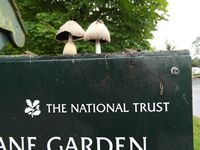
A brief footnote: it would be an incomplete visit to Northern Ireland without taking in the Giant's Causeway on the north coast. Geology and botany rather than horticulture are what count here. The hexagonal pillars of basalt are packed together into a massive stone honeycomb and extend into the sea, showing the route to the Isle of Staffa, from where the giant, Finn McCool, brought his bride to Ulster.
You can ramble over the lower rocks, scramble over the higher ones and take a spectacular circular route round the columns and turrets and along the cliff top. Or, as your correspondent did, tumble into a rock pool, for a too-close encounter with marine wildlife.
Margaret Waddy
Plant of the Month
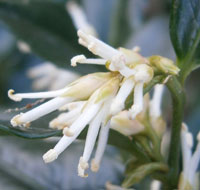
For a blast of beautiful scent on a winter's day, this evergreen shrub is an excellent choice.
This is one species amongst eleven in the genus that hail originally from Afghanistan to China and the Philippines and is the most commonly found in nurseries in the UK. With small dark green leaves in spirals and separate male and female flowers it melts into the background for much of the year.
But come the winter, the black fruits (technically a drupe) glow amongst the white scented flowers of the current season. The male flowers have nectar whereas the female flowers don't. The botanical name comes from the Greek for flesh and berry (sarcos and kokkos) due to the fleshy fruits the plant bears.
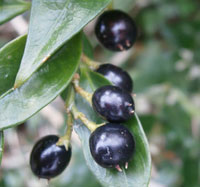
Alison Foster
Oxford Botanic
Garden
Medicinal Plant of the Month
Narcissus ‘Carlton’, daffodil, Amaryllidaceae
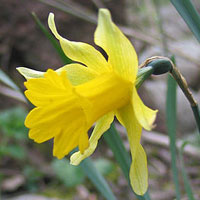
Narcissus, in Greek myth, was the name of a beautiful youth who became so entranced with his own reflection that he pined away and the gods turned him into this flower. The word is possibly derived from an ancient Iranian language. But narcissi are not entirely selfish. As a member of the Amaryliidaceae, a family known for containing biologically active alkaloids, it is no surprise to learn that they contain a potent medicinal agent.
Narcissus (and in particular this cultivar) are an excellent source of galanthamine, a drug more commonly associated with snowdrops (Galanthus spp.). Galanthamine is currently recommended for the treatment of moderate Alzheimer's disease by the National Institute of Health and Clinical Excellence (NICE) but is very effective in earlier stages of the disease too.
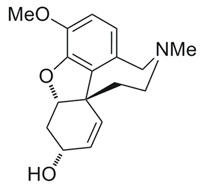
Alison Foster
Oxford Botanic
Garden
News from our Associates
Commercial Horticultural Association


The National Horticultural Forum has been active in helping to establish the
Horticulture Innovation Partnership (HIP). This new body may well take over
from the NHF if it is seen to adequately cover the same interests. The HIP
will be formally launched at a meeting organised by Government Chief Scientific
Adviser, Sir John Beddington, on 7 March.

The VAT exemption for research is being withdrawn from 1 August. Her
Majesty's Revenue and Customs (HMRC) is conducting a consultation to assess
the impact that the withdrawal of the exemption will have and to see whether
there are any possible options to mitigate the impact of the withdrawal. The
Society of Biology will be responding to this consultation. If you have any
comments or case studies to contribute to our response, please contact jackiecaine@societyofbiology.org
Horticulture Industry News
For the very latest horticultural news follow us on Facebook and or
Twitter.
Wind in the willows boosts biofuel production
Willow trees (Salix sp.) cultivated for green energy can yield up
to five times more biofuel if they grow diagonally, compared with those that
are allowed to grow naturally up towards the sky. This effect had been observed
in the wild and in plantations around the UK, but scientists were previously
unable to explain why. Now a genetic trait has been identified that causes
this effect and is activated in some trees when they sense they are at an
angle, such as where they are blown sideways in windy conditions. The effect
creates an excess of strengthening sugar molecules in the willows' stems,
which attempt to straighten the plant upwards. These high-energy sugars are
fermented into biofuels when the trees are harvested in a process that currently
needs to be more efficient before it can rival the production of fossil fuels.
A fourth greenhouse at Thanet
The fourth greenhouse has begun operations at the Thanet Earth site in east
Kent. The new greenhouse covers approximately 8 hectares, and will be dedicated
to tomato production. The cost of construction (including its combined heat
and power infrastructure and its link to the site electrical substation)
has been some £17 million. The greenhouse is owned jointly by the project
partners in Thanet Earth (Fresca Group, Rainbow UK, A&A Growers and Kaaij
UK), and will be managed on a day-to-day basis by Gert van Straalen of tomato
specialist Kaaij UK. More
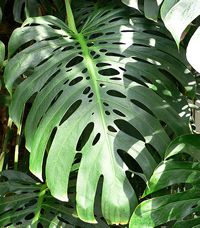
A number of explanations have been put forward for familiar hole-riddled leaves
of the Swiss cheese plant, (Monstera deliciosa), from reduced wind resistance, better temperature regulation and
water run-off to camouflage. Research has now shown that these perforated
leaves allow the plants to capture sunlight more regularly helping them to
survive in shady rainforests. Monstera deliciosa lives in the dark understorey of tropical rainforests. It relies on capturing
unpredictable shafts of sunlight, known as 'sunflecks', in order
to photosynthesise for energy. The larger leaves with their holes are more
efficient at capturing these sunflecks than smaller leaves of similar overall
surface area.
Runts to the Rescue
Logging and violent storms cause massive damage to forests. What is less obvious,
however, is the devastating effect that the removal of trees and vegetation
can have on streams and lakes. Nitrate concentrations in waterways can soar
by as much as 400% when the nitrate tied up in organic matter washes
into streams. Algal blooms and fish die-offs almost always follow this sort
of nitrogen fertilisation event.
A mountain pine beetle epidemic in the west of North America, which now stretches from Mexico to Canada, has killed millions of dead trees would mean serious trouble for local water quality as well. However researchers have found that despite the ravaged appearance of forests in Colorado, where 80 to 90% of the canopy in many watersheds is gone, streams and lakes are remarkably healthy. This seems to be because the small trees and understorey vegetation, that the pine beetles mostly leave alone, appear to be compensating for the loss of mature trees by drastically increasing their uptake of nitrate.
Fungal endophytes help prevent weed invasions
Endophytic fungi, that live within plant tissues are common but their effects
have not been extensively studied. A recent study looked at the impact of one
such endophyte, Scherodonus pratensis, in swards of meadow fescue
(Festuca pratensis). After four years, weeds covered 25% of plots
that were endophyte-free (E-) compared to 2% in endophyte colonised (E+) plots.
Similarly, the proportion of weeds in the total biomass was over 45% higher
in E- plots compared to E+ plots at the end of the six years study. Weed species
richness, coverage and productivity were all higher in E- plots. The results
demonstrate that the presence of endophytes prevent weed invasions.
Chicken or egg: Forests or rain
Conventional theory says that the distribution of forests and deserts
is dictated by the circulation patterns of the earth's atmosphere. Regions
of rising air and low pressure create rain belts such as those that straddle
the British Isles and tropical forests. Conversely regions of high pressure
and falling air create the desert belts, ie rain equals forests.
Now a new study boosts support for the physics behind a controversial theory that forests play a significant role in determining rainfall, creating atmospheric winds that pump moisture across continents. The new atmospheric model puts forward the idea that it is evaporation from the forests that creates the low pressure drawing in moist air and generating rain, ie forests equals rain. This controversial model could revolutionise the way we understand local climates, and their vulnerability, with many major implications. It suggests, for instance, that by strategically replanting forests we could attract rainfall into desert and arid regions like the African Sahel, where drought has for years ravaged crops and induced famine. Likewise, significant forest loss could transform lush tropical regions into arid landscapes. More
'Scarecrow' Gene has a role in C4 photosynthesis
The highly efficient C4 photosynthesis found in certain grasses requires a
leaf structure with many more bundle sheaths than are found the leaves most
plants. Scientists have now found that a gene called Scarecrow, that was known
to control bundle sheath development in roots, also controls the special leaf
structure, known as Kranz anatomy, which leads to more efficient photosynthesis.
Although only a first step in understanding the control of Kranz anatomy,
this finding gives researchers a valuable peg on which to base future research. More
Improving growers' contracting relationships with processors
The first summit of its kind to help UK horticulture and potato growers improve
their negotiation powers and professionalism will take place on 13 February.
The event will include a two hour negotiation workshop on skills and techniques
for dealing with contract negotiations. A range of speakers will also share
experiences from the sugar, dairy, horticulture and potatoes sectors, demonstrate
the value of utilising market data and highlight the support available from
the NFU.
New Director at Cambridge Botanic Garden
Dr Beverley Glover has been named as the new Director of Cambridge University
Botanic Garden. Dr Glover will take up the post, and the associated Professorship
of Plant Systematics and Evolution to which she has been elected, in July
. More
Tree loss bad for human health
The loss of 100 million trees in the eastern and midwestern United States
gave an unprecedented opportunity to study the impact of a major change in
the natural environment on human health. In an analysis of 18 years of data,
researchers found that people living in areas infested by the emerald ash
borer, Agrilus planipennis, a beetle that kills ash trees, suffered
from an additional 15,000 deaths from cardiovascular disease and 6,000 more
deaths from lower respiratory disease when compared to uninfected areas. When
emerald ash borer comes into a community, city streets lined with ash trees
become treeless. More
Senna could treat diabetes
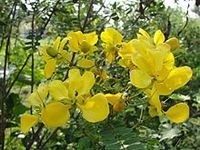
The authors refer to these species by the synonyms Cassia auriculata and Cassia alata which are no longer accepted. More
Toothbrush tree yields antibiotic to treat TB
A compound from the South African toothbrush tree, Euclea natalensis,
inactivates a drug target for tuberculosis in a previously unseen way. The
compound, diospyrin, binds to a novel site on a well-known enzyme, called DNA
gyrase, and inactivates the enzyme. DNA gyrase is essential for bacteria and
plants but is not present in animals or humans. It is established as an effective
and safe drug target for antibiotics.
The way that diospyrin works helps to explain why it is effective against drug-sensitive and drug-resistant strains of tuberculosis. In traditional medicine the antibacterial properties of the tree are used for oral health and to treat medical complaints such bronchitis, pleurisy and venereal disease. Twigs from the tree are traditionally used as toothbrushes. More
Bayer CropScience acquires Prophyta
Bayer CropScience has signed an agreement to acquire Prophyta GmbH, a leading
supplier of microbial crop protection products headquartered in Malchow, along
with the company's R&D laboratories and its state-of-the-art production
and formulation facilities in Wismar, Germany. Prophyta has developed a unique
solid-state fermentation technology for production and bioprocess development
of filamentous fungi. Using this patented technology, large quantities of
fungal biomass as well as fungal spores can be produced under axenic conditions.
Why don't plants get sick more often?
Why are plants immune to most of the diseases surrounding them in the environment?
Called non-host resistance (NHR), the mysterious trait gives plants their
most robust and durable immunity to the myriad pathogens challenging them.
If NHR weren't commonplace in nature, plants would be constantly attacked
by fungi, bacteria and other pathogens swarming in air, soil and bodies. But,
for the most part, plants are immune to those challenges. Research has now
shown that fungal DNase enzymes trigger the NHR response in a variety of plant
species. DNases from fungal mitochondria have a small peptide molecule that
enables them to move through plant cell membranes and thus induce expression
of NHR in the plant. More
Events Calendar
Other Events of Interest
Soft
Fruit Winter Meeting
5 Feb, James Hutton Institute
Dundee, UK
BPOA
AGM and Conference
6 Feb, British Protected Ornamentals Association
Oxford, UK
Fruit Logistica
6 - 8 Feb, Messe Berlin, see also Commercial
Horticultural Association
Berlin, Germany
Catalyst
for Change: NFU Grower Representative Summit
13 Feb, National Farmers Union
Stoneleigh, UK
Landscape Industry
Show
13 - 14 Feb, California Landscape Contractors Association
Los Angeles, USA
Making Britain
the Best Place in the World to do Science
19 Feb, The Royal Society
London, UK
Salon du
Vegetal
19 - 21 Feb, Bureau Horticole Régional, see also Commercial
Horticultural Association
Angers, France
New Technologies
for Sustainable Agricultural Production and Food Security
24 - 26 Feb, International Society for Horticultural Science
Muscat, Oman
Environmental Management
and Crop Protection
25 - 26 Feb, Association for Crop Protection in Northern Britain
Dundee, UK
Poland
– Chance or Challenge
2 - 9 Mar, Under 40s Fruit Growers Tour
Poland
British
Plant Fair
7 Mar, The British Plant Fair
Stoneleigh, UK
Slow-
and Controlled-Release and Stabilized Fertilizers
12 - 13 Mar, New AG International
Rio de Janeiro, Brazil
Green
Health Conference
11 Mar, James Hutton Institute
Dundee, UK
New
AG International
13 - 15 Mar, New AG International
Rio de Janeiro, Brazil
Evolution
of the Plant Soil Interface
19 Mar, James Hutton Institute
Dundee, UK
Pesticide Use and Risk Reduction
for Future IPM in Europe
19 - 22 Mar, Fondazione Edmund Mack, Pure, Laimburg
Riva del Garda, Italy
From
Farm to Fork – Plant Molecular Breeding and Post-harvest Research
in the 21st Century
23 Mar, PlantLink, Food Technology at Lund University and Department
of Plant Breeding
Lund, Sweden
Crop
Resource Use Efficiency and Field Phenotyping
25 - 26 Mar, Association of Applied Biologists
Grantham, UK
Middle East
Horticultural Summit
26 Mar, International Society for Horticultural Science
Dubai
Temperate Zone
Fruits in the Tropics and Subtropics
26 - 28 Mar, International Society for Horticultural Science
Chiang Mai, Thailand
Flowers
& Hortech, Ukraine
9 - 11 Apr, BTO Exhibitions
Kiev, Ukraine
UK PlantSci
16 - 17 Apr, UK Plant Science Federation
Dundee, UK
IFSTSpring conference 2013: Securing the Future Supply of Food
17 Apr, Institute of Food Science and Technology
Norwich, UK
Grapevine
Physiology and Biotechnology
21 - 26 Apr, International Society for Horticultural Science
Santiago, Chile
Discovery and Development
of Innovative Strategies for Post-harvest Disease Management
29 Apr - 2 May, International Society for Horticultural Science
Kusadasi, Turkey
If you would like to advertise a forthcoming event please contact. karen.hobbs@soci.org
Horticulture Group Contact Details
For submitting ideas or to volunteer to be part of a committee or a group, please contact:
Chairman - Peter Grimbly
Meetings Secretary - Alison Foster
Minutes Secretary - Margaret Waddy
Newsletter co-ordinator - Sue Grimbly scihortigroup@btinternet.com
Group Contact - Karen Hobbs, E: karen.hobbs@soci.org T: +44(0)20 7598 1586
